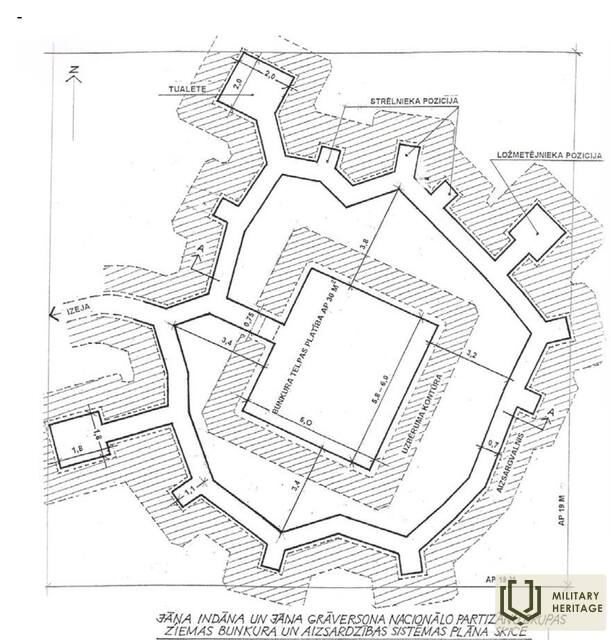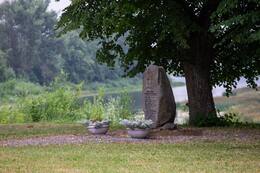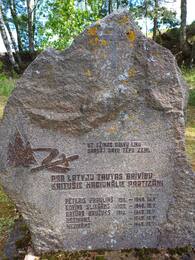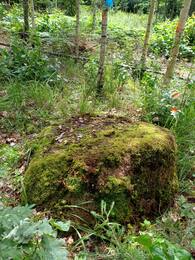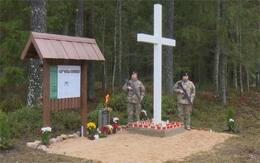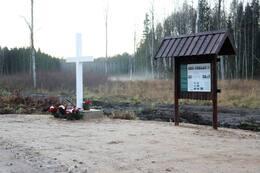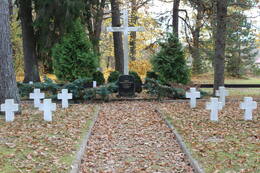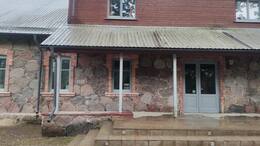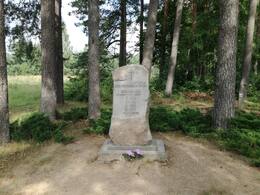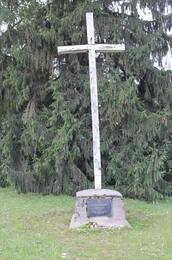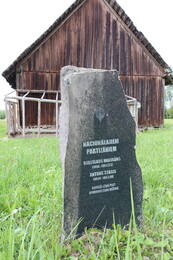Settlement of Sēlija forest brothers in Sūpe bog
Sūpe soo on seotud inimeste ja paikade koosmõjus välja kujunenud sissiasustus- ja võitluskohtadega. Seda kirjeldab lätlasest pagulase Albert Eglīse ballaad sündmustest tema kodumaal Sūpe rabas "Sammal ja muda" – austusavaldus Sūpe soo partisanidele:
„“ 1945. aastal soos hõõgumas
Pokļevinska sünnipäeval jagab Lieljānis õhtusööki:
Paju kääritatud õlu,
Romulani kultusvõi,
Kuiv ema köömneleib
Kuivatatud sink,
Ja Stucka sibul,
Pikk juust.
Toad vaikseintes
Dun välk tabas südameid,
Ja üksteist hinge
Maapealsed juured…”
See minevikutõlgendus koos Teise maailmasõja järgsete sündmustega hõlmas inimlikku tunnistust, vaimu väljendamist ja väärtuste süsteemi. See tuletab meelde rahva toetust rahvuspartisanidele, keda okupatsioonivõim ei saanud nii kergesti lüüa. Pärast elanike küüditamisi 25. märtsil 1949 hävis rahvuspartisanide varustussüsteem. 1949. aasta suvest kuni 1952. aasta keskpaigani oli Sēlija rahvuspartisanide vastupanuliikumine Aknīste, Biržai, Elkšņu Gārsene, Sauka, Susēja ja Viesīte ümbruses languses. Lüüasaamise põhjuseks oli etniline puhastus ning regulaarne armee ja julgeolekuteenistus.
Nii tõsise kaitsesüsteemiga Indan-Gravelsoni asulat ei eksisteerinud 1950. aastatel enam kusagil mujal Lätis, sealhulgas Selia lõunanaabris Leedus. Talveperioodil 1949-1950 Elkšņi metsas asuvat Indan-Gravelsoni rühmapunkrit iseloomustab tollal ainulaadne linnus. Spetsiaalselt disainitud ringkaitsesoonte ja relvapesadega. Pereliikmeid ei suudetud eraldada ning vastutuse nende turvalisuse eest võtsid eeskätt sõjalise kogemuse saanud mehed, aga ka naised ise, kes ei kartnud relva haarata. Nende eesmärk ohu korral oli ründaja tõrjumine. Seda sõja lõpufaasis avaldunud erilist identiteeti iseloomustab repressioonidest pääsenud pereliikmete kaasamine. See väljendus ka psühholoogilises ettevalmistuses ning saatuslik tulemus polnud enam üllatus. Indan-Gravelsoni rühmitus oli oma lootusetust olukorrast hästi teadlik ja oli valmis surmani võitlema.
Indan-Gravelsoni rahvuspartisanide ühisrühm:
Rühmavanem Jānis Indāns, Pēteris Indāns, Kristīne Indāne, Milda Ārija Indāne, Vasilijs Sokolovs, Jānis Ķepiņš, Hilda asetäitja, Artūrs Snikus, Alma Grāvelsone, II rühmavanem Jānis Edvards Grāvelsons, Jonas Žukauskas.
Suuline tunnistus
Partisanide sidemees Jānis Snikus: “Mārtiņš Pokļevinskis näitas partisanide ühishauda ja ütles, et tõmbas mu venna Artūrs Snikase haua otsa, asetades pea põhja poole. Mārtiņš Pokļevinskis väitis, et partisanid andsid liiga odavalt pead, sest punkrist tuli lahkuda alles pimeduse saabudes, et sealt läbi murda. Partisanide ühishauale asetati pärg. Matsime koos Mārtiņš Pokļevinskisega kiiruga maha partisani Voldemārs Sātnieksi, kes oli jäetud võimalikult metsa maetud. ”
Vilma Birša (Saulīte): “1950. 2006. aasta kevadel, enne tabamist, vaatasime Mārtiņš Pokļevinskiga Indan-Gravelsoni punkrit ja leidsime punkri lähedalt partisanide matmispaiga. Pokļevinskis proovis pika kaardiga kukkunuid nägema keerata, selgelt nägin indalasi, Snikus Artūrsit ja Mildiņšit. Ma ei saanud enam vaadata, sest see kõik oli talumatult raske. Lahingupaigas visati sõdurimütse. Näha oli kohti, kus väed olid maskeerunud kuuseoksteks ja ootasid partisanide punkrist lahkumist.
Jānis Plāns: „Töötasin Viesīte raudteejaamas rongis ja pidin sel kuupäeval sõitma Elkšņi haru 22. kilomeetril metsamaterjali laadima. 14. kilomeetrile lähenedes peatati meid sõjaväe korraldus, sest tulistamine oli alanud. ” Pärast tulistamist kästi Jānis Plānis: “ложись” – heida pikali. Jānis Plānis täidab käsku ja lebab rongiplatvormil. Kui rong lasketiirus läbis, nägi ta iga puu taga valgetes kamuflaažiriietes sõdureid. 22 kilomeetrile lähenedes jätkus veelgi intensiivsem laskmine. "Kui me puidu rongile tagasi panime, oli laskmine lõppenud, kuid kogu mets oli endiselt ümbritsetud." Pärast neid sündmusi suvekuul 14. kilomeetril, kui koos juhiga metsamaterjali laaditi, läks Jānis Plāns sündmuskohta vaatama. Punkri juurde jõudes oli näha selline väike künkake, selle ümber kasvasid väikesed jõulupuud. Punker oli kõigi kaevikutega terveks jäänud, punkrisse sisenedes oli see tühi, lagi ei olnud kõrge, kuid kere sai sirgeks ajada. Punkri sees mäletab Jānis Plāns, et seal oli laud ja sissepääsu ees oli näha kahe korruse pinke. Punkrist 10 meetri kaugusel asub kivikoldega saun.
Hilda Miezīte (asetäitja): „Rünnak toimus hommikul, lund oli veel vähe. See oli reetmine ja metsavaht. ” Hilda Miezīte mäletas, et ümberringi oli kuulda autode mürinat ja lisajõude oli tulnud. Hilda ei saa aru, kuidas ta ellu jäi, sest kuulid läksid igast küljest. Ta arvas, et nad lahkusid punkrist, kuna ei suutnud kinni pidada, visati granaate ja kostis kõlareid. Asula häviks nii või teisiti. Metsas elades ei tohtinud keegi asulast lahkuda, valitses range distsipliin ja hüüdnimed olid olemas, et mitte oma isikut paljastada. Mehed on valvepostil regulaarselt vahetunud. Punkri katus oli ehitatud ümarpalgist, väikese tõusuga madal, kaetud mulla, mäda ja samblaga. Sissepääsu poolel väike kõrgendus väikese kaldega vastasküljele. Sissepääsuuksest paremal oli väike aken. Punkris olid pingid ja pliit oli keskel. Asju polnud palju, majapidamistarbeid - riideid mõnel sama palju kui seljas. Asula ruumides mängiti vinüülplaatidega fonograafi, mida vahel vaikselt kuulati.
Jõulupuu. Päikesevaba aja laulud: ajakirjaniku lüürilised noodid. [Minneapolis]: Selzemnieks, 1983, lk 28].
Seotud ajajoon
Seotud objektid
Memorial stone to the Rihards Pārups group of national partisans
It is located on Rīgas Street near the Krustpils Lutheran Church.
On September 22, 1996, a memorial stone to Rihards Pārups and the group of national partisans led by him was unveiled in Krustpilis. The memorial stone was created by the sculptor Ilgvars Mozulāns, but its creation was financially supported by the speaker of the Saeima, Ilga Kreituse. This event was organized by the board of the National Partisan Association of Latvia.
Rihards Pārupa's national partisans,
who were murdered by the Cheka special group
Rihards Pārups (1914 - 1946 2.VII)
Group commander
Rihards Stulpiņš (1923 - 1946. 2. VII)
Alberts Avotiņš (1912 - 1946. 2. VII)
Eric Juhna (1928. -1946. 2. VII)
Aleksandrs Lācis (1919 - 1946. 2. VII)
Pēteris Lācis (1921 - 1946. 2. VII)
Jānis Ēvalds Zālītis (Āboliņš) (1911 - 1946 2. VII)
Siegfried Bimstein, Theodor Schmidt (... - 1946. 2. VII)
Uldis Šmits (... - 1946. 2. VII)
Pēteris Lazdāns (1926 - 1947. VI)
Eric Konvals (1929 – 1947. VI)
Niklas Ošiņš (1908 – 1954. 12.X) – executed in Riga
Alberts ħiķauka (1911 – 1972. II) – imprisoned in the Mordovian camp
Rihards Pārups was born on June 11, 1914, in "Kakšiš" of Krustpils parish. During the Second World War, he was a sergeant in the anti-tank division of the 15th Latvian Division. Participated in national partisan operations in the vicinity of Jēkabpils and Madonas and was a member of the National Resistance Movement, unit leader in the vicinity of Jēkabpils and Madonas. Rihards Pārups fell in battle with Czech troops on July 2, 1946 in Vietalva parish. Unfortunately, the burial place is unknown. A commemorative plaque has been installed in the Riga Brothers' Cemetery. In the fall of 1945, a group of national partisans, led by R. Pārups, was formed in the Jēkabpils district. During its short existence, it participated in more than twenty armed clashes with units of the then Ministry of the Interior. In the report of Cheka's colonel Kotov to the Riga headquarters, it is stated that the activities of the Soviet authorities in Jēkabpils and Madona districts were effectively paralyzed as a result of the group's activities during this time. The national partisans led by R. Parupa found and destroyed several lists to be sent out, thus saving the lives of many people. The leadership of the Security Committee, unable to destroy the national partisan unit in an open battle, infiltrated into it four people from the Czech special group, who shot ten partisans of the unit, including R. Parup, on the night of July 2, 1945. In 1947, two more were shot near Jaunkalsnava, and in 1951, one member of this unit was shot. After twenty-five years of hard labor in the Mordovia camp, a few days before liberation, the fourteenth partisan of the group led by R. Parupas died.
Memorial place for the members of P. Prauliņas national partisan group in Vidsala
The group of national partisans of Pētera Prauliņa (1911-1949) of Biržu parish was part of the group led by Mārtiņas Pokļevińskas (1902-1951). The group carried out several partisan actions in which they punished Soviet collaborators and requisitioned food and property of the economic institutions of the occupying power. The partisans of P. Prauliņa's group did not observe sufficient conspiracy, many persons visited their settlement, which created an opportunity for betrayal. Lack of military experience was one of the weaknesses of the guerrilla armed movement.
P. Prauliņa's partisan group was destroyed on May 16, 1949 in the Kalna forest of Biržu parish during the operation of the Ministry of State Security of the LPSR, in which military units also participated. The Forest Brothers had created a bunker with circle defenses, well camouflaged and located at an indeterminate height in a swampy area. The partisans fiercely resisted the Czech army units for at least 40 minutes, but the entire composition of the group fell: Pēteris Prauliņš, Artūrs Bružuks, Jānis Kalvāns, Edvīns Slikšāns and Francis Skromanis. The forest brothers who were shot were dumped near the parish house, but their remains were later buried in nearby gravel pits. Irma Bružuk was seriously wounded, who was captured and died on May 17 in Jēkabpils hospital. She was buried outside the cemetery, but when the cemetery was expanded after the restoration of Latvia's independence, a monument was placed on her grave.
The memorial stone for the partisans of P. Prauliņa's group in Kalna parish was consecrated in November 1998. The place of P. Prauliņa's bunker is located in the 4th district of the 99th block of Vidsalas, Kalna parish. The stone on which P. Prauliņš sat has been preserved.
Bunker site of P. Prauliņa's national partisan group
The place of P. Prauliņa's bunker is located in the 4th district of the 99th block of Vidsalas, Kalna parish. The stone on which P. Prauliņš sat has been preserved.
The partisan group of P. Prauliņa (1911-1949) was destroyed on May 16, 1949, during the operation of the Ministry of State Security of the LPSR in the Kalna forest of Biržu parish, in which military units also participated. The Forest Brothers had created a bunker with circle defenses, well camouflaged and located at an indeterminate height in a swampy area. The partisans fiercely resisted the Czech army units for at least 40 minutes, but the entire composition of the group fell: Pēteris Prauliņš, Artūrs Bružuks, Jānis Kalvāns, Edvīns Slikšāns and Francis Skromanis. The forest brothers who were shot were dumped near the parish house, but their remains were later buried in nearby gravel pits. Irma Bružuk was seriously wounded, who was captured and died on May 17 in Jēkabpils hospital. She was buried outside the cemetery, but when the cemetery was expanded after the restoration of Latvia's independence, a monument was placed on her grave.
The group of national partisans of Pēteras Prauliņas Biržu parish was part of the group led by Mārtiņas Pokļevińskas (1902-1951). The group carried out several partisan actions in which they punished Soviet collaborators and requisitioned food and property of the economic institutions of the occupying power. The partisans of P. Prauliņa's group did not observe a sufficient conspiracy, many persons visited their settlement, which created an opportunity for treason. Lack of military experience was one of the weaknesses of the guerrilla armed movement.
The memorial stone for the partisans of P. Prauliņa's group in Kalna parish was consecrated in November 1998.
Memorial place for members of J. Indan - J. Gravelson and M. Poklevinska national partisan groups
Informative stand and memorial place for Indān - Gravelson's national partisan group in Kalna parish of Jēkabpils county, in the vicinity of Sūpes purva, opened on Lāčpleš day - November 11, 2019. Its opening was attended by representatives of Jēkabpils and Viesītes counties, former national partisan H. Miezīte, historian H. Bruņinieks, as well as guests from Lithuania and other interested parties. The memorial site and the stand are located by the Sūpe swamp, which is connected to the places of settlements and battles of the national partisans. Deeper in the forest was also the bunker of the Indan-Gravelson group.
After the deportations of Latvian residents on March 25, 1949, the supply system of the national partisans was destroyed. From the summer of 1949 to the middle of 1952, the national partisan movement in the vicinity of Aknīste, Sauka, Elkšť, Birži and Viesīte experienced its decline, as it suffered from ethnic cleansing and regular countermeasures by the Soviet army and security authorities. The settlement of the group of national partisans of Jānis Indāns and Jānis Gravelsons in the Elkšņu forest, 1949-1950. during the winter period of 2010, there was a very serious defense system, uncharacteristic of that time, which did not exist anywhere else in Latvia or in its neighboring country, Lithuania, in the 1950s. The bunker of the Indan-Gravelson group had specially designed circular defense trenches and gun emplacements. Along with the military readiness of the partisans to sacrifice their lives in the fight against the enemy, it is also possible to talk about their special identity, which was also manifested in the involvement of the other family members in the ranks of the national partisans.
12 people worked in the joint partisan group of Indāns-Grāvelsons, including five women and one Lithuanian partisan: Jānis Indāns, Jānis Edvards Grāvelsons, Alma Gravelsone, Pēteris Indāns, Kristīne Indāne, Milda Ārija Indāne, Vasilijs Sokolovs, Voldemārs Otto Sātnieks, Jānis Ķepiņš, Hilda Deputy, Artūrs Snikus, Jons Žukauskis. Their last battle took place on February 25, 1950 in the Elkšņu forest, when 11 partisans fell in the fight against disproportionate numbers. Only Hilda Vietniece (Miezite) survived, who was captured and later spent six years imprisoned in Gulag camps.
Memorial site at the site of the battle of the national partisans on February 13, 1945 in Dimantu Meze, Kalna Parish
The memorial site has been created by the regional highway P74 Siliņi - Aknīste, 12 kilometers from Aknīste turning to the Latvian national forest "Žagaru road".
At the end of the summer of 1944, the vast forest massif of the northern part of Elkšť parish became a gathering place for people who were preparing for an armed struggle against the Soviet occupation. At the end of 1944, groups of national partisans began to form around Aknīste. A suitable place for the establishment of a partisan camp was the Dimantu mež , which was located on the southern edge of the large Elkšņi forest, near Aknīste Great Marsh. There, less than 10 kilometers from Aknīste parish, the national partisans created three winter bunkers for wintering. The connections of the men gathered in the forest were ensured with the support of the residents, neighbors and partisans of the nearby houses - Baltimore, Gargrode, Lichi, Priede, Krumi and other houses.
The partisan battle with the soldiers of the State Security Ministry of the LPSR took place in the Diamond Forest on February 13, 1945. The Chekists, having captured the hostages, drove them forward to show them the partisan bunkers. The forest brothers, seeing the danger, opened fire without sparing the hostages. 10 representatives of the Soviet occupation troops, eight national partisans and four hostages died in the battle. Despite the losses of the forest brothers, the Chekists failed to capture the partisan bunkers. The surviving partisans waited for darkness and left the settlement. Czech soldiers wounded in the battle could not leave the kingdom, moaning. After this battle, which can be considered the first "baptism of the forest brothers", the partisans felt like brothers and the rifle seemed more precious than anything else, as the only reliable savior.
The white cross and the information stand were installed in the Diamond Forest on Lāčpleš Day - November 11, 2022. The creation of the memorial has been supported by the municipality of Jēkabpils region, the association "Tēvzemes sargi" and Latvian state forests. The author of the content part of the informative stand is historian Haralds Bruņinieks.
Cemetery of the Brothers of the National Partisans of Selia
The graves of the brothers of the national partisans of Selia were opened on October 30, 2004 with the support of the Ministry of Defense of Latvia and Aknīste municipality. Partisans Alberts Karankevičs (1914-1949), Vilis Tunķels (1911-1949), Arnolds Tunķels (1926-1949), Osvalds Tunķels (1929-1949), Ēvalds Kundzāns ( 1927-1949).
partisans Juris Alfreds Voldemārs Lācis (1908-1945), Eduards Kaminskis (1910-1945), Osvalds Mežaraups (1911-1945), Alberts Mežaraups (1915-1945), Antons Bružiks (1911-1945), Jānis Britāns (1926-1945) and one unknown. Marta Mežaraupe (1907-1945), Alberts Lācis (1902-1945), Juris Resnītis (1901-1945) and Pēteris Bite (1907-1945), as well as the groups of Indān-Grāvelsons, who fell during the battle and were taken hostage by the Soviet occupation authorities, are also buried in the common cemetery. fallen partisan Voldemārs Otto Sātnieks (1911-1950). There is also a monument to Alfred Silaraup (1925-1946), a national partisan of the Aknīste company, who fell during a check operation on July 30, 1946, on a narrow-gauge railway in the Elkšņu forest.
A black granite stele with the emblem of the National Partisans Association of Latvia is placed at the foot of the White Cross installed in the cemeteries of the Brothers of the National Partisans of Selia and the text "For the national partisans of Selia. You sacrificed your lives for Latvia in the fight against the communist occupation regime in 1944-1954." There is also a memorial stone in the grave area with the inscription "There are tears that will be done in silence." There are scars that won't heal if healed", which Stanislav Šadurska installed at the beginning of the Awakening at the pit where the Chekists buried the national partisans and hostages who had fallen the day before on February 14, 1955.
The former Susėja Parish Hall, the site of an attack by national partisans on July 7, 1945
Today, the building of the former Susėja Parish Hall houses the Sansusī Residence Center and the guest house "Susēja". On the facade of the building you can still see the traces of the attack, left by the bullets fired during the attack of the national partisans on July 7, 1945.
The former Susėja Parish Hall, which at that time functioned as the local executive committee of the Soviet occupation power, suffered an attack by the Selia national partisans on July 7, 1945. The attack on the executive committee of Susėja was a part of a wider action by national partisans and took place simultaneously with the attacks on the Vilkupe dairy and the house of the exterminator Kaunacka.
According to the instructions of Albert Kaminsky (1920-1946), the commander of the national partisan group of Suseya, the forest brothers were supposed to destroy the security of the local executive committee, take weapons, militia uniforms, documents and destroy telephone communications. About 17 Lithuanian partisans of the forest brothers participated in the attack on the Susėja executive committee under the leadership of Jozos Kuveikais. The battle lasted 15-20 minutes, one Lithuanian partisan fell during the shooting, and on the opposite side - fighter battalion fighter Jānis Kakarāns. During the shooting, the windows of the executive committee were broken and the telephone was damaged.
The second attack on the executive committee of Suseia took place on July 16, 1945, when a longer firefight took place between the forest brothers and fighters of the fighter battalion who sought refuge in the executive committee building. During the battle, a group of Soviet soldiers came to the aid of the latter, who opened machine-gun fire from the flank and forced the partisans to retreat. At least five forest brothers and five destroyers fell in the battle. Attacks on this administrative object of the occupying power proved the nature of the armed resistance of the guerrilla war and were a warning of the people's resistance to the Soviet occupation power.
Monument to the national partisans of Susea
The unit of national partisans of Susea was formed from smaller, fragmented groups of forest brothers, because initially there was a lack of a leader who could unite them. Artūrs Grābeklis, later Markeis Gorovņov, who died in the winter of 1945, tried to coordinate the activity of Susėya partisans for a short time. The strengthening of the national partisan unit of Suseia took place after the arrival of the former legionnaire Alberts Kaminskis in Selia after the general capitulation of Germany in Kurzeme. He established stricter discipline and united smaller groups for a common struggle against the Soviet occupation. Cooperation was also formed with groups of forest brothers from nearby parishes and surroundings, especially with the Gārsene group and Lithuanian partisans who had settled on the border between Lithuania and Latvia.
In the early stages of the armed movement, it can be seen that the forest brothers were not prepared for attacks, unable to occupy the Kaunacka homestead, nor to break into the building of the executive committee of Susėja. The partisans suffered losses and were not able to resist the Czech troops for a long time, and the main method of fighting was to think about retreating in time. There was also a problem with the supply of the partisans. In spite of the difficulties, the national partisan unit of Susa was still able to actively resist the Soviet occupation in the first post-war years. This partisan group ceased to exist after the death of its commander A. Kaminsky on May 14, 1946. This was followed by the legalization of several forest brothers, as well as the joining of other guerrilla groups.
The monument to the national partisans of the Suseia detachment was opened on November 11, 1997, following the initiative of the researcher of the history of the national partisans of Selia, Gunārs Blūzma. Next to the words of the fallen national partisans of Susėja, the text: "On the head of a hedgehog, protect the land of your fathers" is engraved in a rough-hewn boulder under the sign of the cross. The memorial mentions those who died in the attack on the Susės executive committee on July 16, 1945 - Jānis Grābeklis (1923-1945), Ādolfs Rācenis (1919-1945), Bronīslavs-Arvīds Bīriņš (1919-1945) and Edgars Ārglis (1920-1945), later added the murdered Names of Lina Kaminska (1917-1945) and Albert Kaminska (1920-1946). Arnold Dombrovskis (1923-1945) and other national partisan groups of Susėja in 1945-1946 are missing from the monument. the names of active and fallen national partisans.
Memorial place for Latvian and Lithuanian national partisans
The white cross with a stele for the national partisans of Slate in Rubene parish was consecrated on October 25, 2002.
It was a joint group of Latvians and Lithuanians, led by Jāzeps Fričs (1920-1947). The group also included Lithuanian partisan commander Jozas Streikus (1923-1962), Jānis Ruzga (1924-1948) and other national partisans who actively resisted the Soviet occupation regime in Slate and nearby parishes.
Memorial site at the site of the July 2, 1945 battle of the national partisans
A memorial stone to the national partisans Jānis Abaron, Vladislav Būkas, Pēteris Bernāns, Alberts Klimans, Vladislavs Dilans and Juris Timšanas who fell in the battle of Dunava on July 2, 1945 and were then burned in Rubene parish.
The Battle of Dunava broke out after two officers of the People's Commissariat of Internal Affairs of the LPSR and one militiaman fell in the clashes between forest brothers and representatives of the Soviet occupation authorities in Ataugas of Dunava Parish on the evening of June 30 and July 1. On July 2, 16 national partisans under the leadership of Eduards Platkanis fought a battle with fighter jets, militia and Cheka soldiers at the turn of the Rubene road behind the Dunava cemetery. A few days later, as a revenge, the Chekists burned the houses of Ataugu, but publicly burned the corpses of the six national partisans who fell in the battle of Dunava near the Rubene parish hall.
Monument to national partisans B. Mikulanas and A. Staris
The monument to the national partisans of the Ilūkstes partisan regiment of the Latvian National Guards (partisans) association Boļeslav Mikulānas (1918 - 1951) and Anton Staris (1909 -1953) in the "Kuršu" homestead in Celminiekos, Dunava parish, was opened on November 1, 2003, following the initiative of Gunārs Blūzma, a researcher of the national partisans of Selia .
From August 1944, B. Mikulāns was active in various national partisan groups, including the Bebrene group and the Dignāja group in 1949. 1949/1950 B. Mikulāns together with A. Stari hid with Jānis Brakovka in Kurši on the edge of the large forest of Bebrene Celminieki. On May 9, 1951, when B. Mikulāns went to get the products, he was murdered by the officer of the 2-N section of the check, Švaroj. A. Staris committed suicide in March 1953 after the Chekists surrounded Kuršu.
In the memorial stele made of granite, next to the names of the fallen national partisans B. Mikulanas and A. Stara, the inscription: "Falled in the fight against the communist regime" is engraved.




